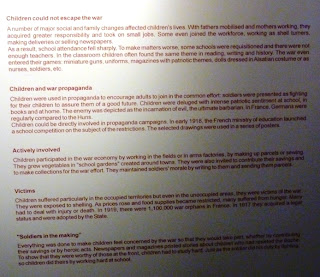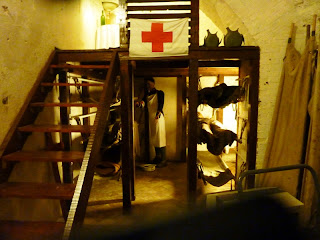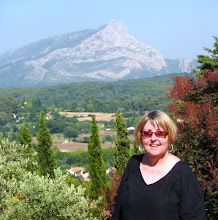Many of you know that I have a thing about WWI and the 1900-1920 time period in general. There's something about the art, the music, the writing and the times that seems to speak to me. This was my 3rd visit to Verdun. I went in 1977 when I was traveling on my own. I went on my own in the mid-1980s when I lived in Germany. Both those times, I only visited the Ossuary and its immediate area.
The battlefields and trenches are now almost 100 years old and very overgrown with the trees that self-generated after the destruction of the war. The forest has taken over greatly from when I was there about 30 years ago. But the horrors of what happened there still remain.
What started WWI? It seems to be the usual reason, greed for power and territory among the European players with a little old-fashioned revenge thrown in. Go to the Wikipedia article to get a good description of why and how it all started.
This is the Ossuary. Although we could not see the stacked bones shown at the link due to construction, it was still a sobering site.
If you can't tell by these pictures, it is in the shape of a cross. Trout climbed to the top to look at the area. The weather was so nasty, we were almost the only ones there.
I walked through the memorials inside. They had an excellent display of pictures of soldiers and at least one nurse who was there then. It included their WWI era pictures and later pictures from when they were quite old.
I then went to the movie and was able to see an English version. It was only available in French and German the other 2 times I was there.
This is the memorial for the Trench of the Bayonets. The story goes that the soldiers were all killed as they were in their trench with their bayonets sticking out ready to defend their position. They were buried that way from the war activity. When the trench was discovered after the war, there was a body beneath each bayonet, so they were left that way. Over time souvenir hunters stole the rusty bayonets sticking up. Now there are crosses marking each man. I would swear that when I first saw this, at least some of the bayonets were still there, but maybe that is just wishful remembering. The memorial was paid for by Americans.
These are some of the markers for those who died at Verdun. Notice that there are lots of Muslim markers as well as Christian ones. Muslims from many French colonies fought for the French in WWI.
These are some of the still visible trenches. Remember that after the war there were no trees, no grass, just holes, debris and destruction. Even when I was there in the 80's, the trees were considerably smaller.
Whether "preserved" or natural, there are still some areas were you can see what's left of some of the trenches. These are very shallow. As you can see from some of these contemporary pictures, the trenches were usually quite deep so that the soldiers would be protected.
This display from the memorial museum, is a good depiction of what the battlefield was like.
This is the front of the Memorial de Verdun. The guys in uniform off to the right are German soldiers. You may remember from your world history or geography that this Lorraine part of France went back and forth between Germany and France many times.
These are some of the typical museum displays inside.
This shows some of the fighters from Muslim countries.
And here are the Americans.
I was particularly interested in this information on what women did during the war. Click on it so you can maybe read it.
And this is how children helped.
There are 2 forts left standing and now possible to see. Verdun is very hilly and they were both built into those hills. This is a bit of information about Fort Douaumont.
And these are some pictures inside. Anytime you see a memorial like this pictured it means that those who died at the fort(s) were buried behind the walls. There are hundreds behind each similar memorial.
These are some pictures of the hallways underground. It was rainy when we were there, as I expect it was during the nearly year-long battle at Verdun. Wet, cold, miserable.
Some of the hallways had these little jags in them to use defensively if any of the enemy got inside.
These were sleeping bunks.
Here's another memorial with men walled up behind.
Primitive electriciy.
Not then, but now, in these cave-like conditions, stalagtites are starting to form.
This is a shaft even farther underground.
Here's Trout bundling up as he comes out.
These pictures are from Fort de Vaux. It is set up more like it was during WWI.
Another memorial. By now, you know what that means.
They did have some big guns.
Here are the Battle of Verdun statistics -- in English and in French. Click on the pictures for easier reading.
Even though in an earlier posting I commented on how WWII affects us, this seems worse to me. A whole generation of French, German, Russian and Austro-Hungarians and men of other nationalities was lost. Ten million in total. About 720,000 died at the Battle of Verdun alone, nearly equally divided between French and Germans. That's almost 100,000 more than died in our Civil War of all causes over its 4 years. As each day passes I wonder if we as a species will ever learn.










































